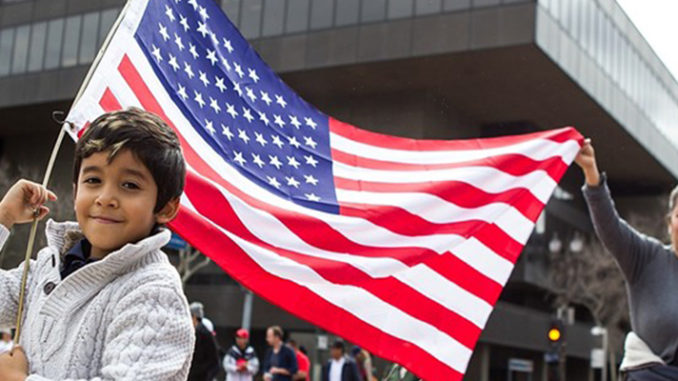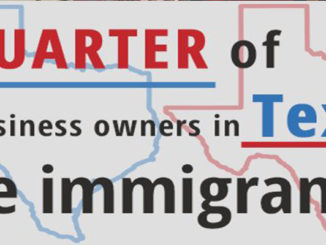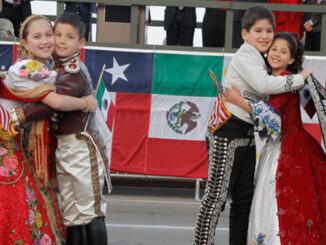
Despite my family’s rootedness in Southern California, migration has had an inordinate effect on my life. Now that it has come to a virtual halt, how do I see myself? Angeleno, as always.
by Gregory Rodriguez
The news that Mexican immigration to the United States has come to a virtual halt has me thinking about all the ways that will change things. It will affect politics, culture, labor and the nation’s racial climate. And it will also change how we see each other and ourselves as Americans and as Californians, me included.
I’m one of those mythical native Californians you might have read about. I was born near the corner of Sunset and Vermont in Hollywood. My father was born in L.A. and baptized, as was I, at La Placita Church downtown. My mom was born in northern San Diego County and baptized at the San Antonio de Pala mission there. My paternal great-grandfather arrived in the U.S. — Arizona — from Mexico in 1893. My family has been American so long that sometimes I think I should wear one of those buckled Pilgrim hats.
And yet, despite my rootedness in Southern California, migration has had an inordinate effect on my life, especially my intellectual and professional life. I’ve always been something of a tour guide, interpreter and even a booster for my regional homeland. As a young Dodgers fan I always resented that half the stadium would root for the Chicago Cubs. I pronounced the glories of L.A. to my friends whose parents longed for the hometowns — New York, Milwaukee, Saigon — they left behind. (And then there’s my love life. I once realized that most of the women whose lives have collided with mine were from families — Korean, Japanese, Vietnamese, German, Mexican — that arrived here because of migration’s big catalyst: wars we fought or labor shortages caused by those wars.)
As a kid, of course, some still saw my ethnicity and skin color as signs of my being an outsider. In third grade I was called the “N-word.” By the 11th, the haters had wised up and switched to more “accurate” ethnic slurs. There were also incidents outside school, and what they all had in common was that they were committed by white kids who had fewer choices than I did. Their words stung, but they didn’t keep me from being elected class president. As a suburban upper-middle-class kid from an educated family, I pretty much felt I could be what I wanted to be, and I chose to be an Angeleno.
Back then, although I was sometimes rudely reminded that I was supposedly lesser than white folk, my identity as an American, a Mexican American and a local was secure and expansive. Sure, in college more than a few people just figured I was from the barrio. But my ethnicity wasn’t automatically assumed to determine all my cultural tastes or political stances.
But that began to change as Mexican immigration reached historic numbers. In 1970, 84% of adult Latinos in L.A. County were U.S.-born, and the majority of them were the grandchildren of immigrants. Twenty years later, that number had been turned upside down: two-thirds of adult Latinos here were foreign-born. Suddenly, like many latter-generation Mexican Americans, I had to grapple with immigration and what it meant for me, my city, my country.
Businesses of all sorts, including newspapers, started looking for educated English-dominant Latinos to interpret the newly transformed marketplace. Once again I found myself in the position of interpreter, not as the prideful insider I’d been growing up but as an observer of a cultural shift.
It was impossible not to be swept up in the debate over immigration, legal and illegal. Though immigrant-bashers always insisted their beef was with illegal immigrants, long-established Mexican Americans were not immune from their invective. A combination of demographic change and a polarized debate had imposed the specter of foreignness — even illegality — on all of us.
And stereotyping didn’t come just from your racist yahoos. A few years ago, the organizer of a Los Angeles Times-sponsored event asked me to sit on a panel discussing democracy in Latin America. Although I had written a weekly column for the paper for six years, she didn’t seem to get that the focus of my writing, my expertise, has always been U.S. society.
There are worse assumptions, to be sure. But in my career, I’ve had to contend with my apparent foreignness over and over. You’d be shocked to know how many smart people presume to know what I like or think based on my last name, or ascribe beliefs to me based on my ethnicity. And then there are the people who insist on speaking to me in pidgin Spanish.
Now comes the end of the largest wave of immigration from a single nation in U.S. history. It carries all sorts of benefits.
Mexico can start rebuilding a civil society that’s been hemorrhaging productive people for far too long. California, where migration from other states is all but over as well, now has an emerging homegrown majority population that has a demonstrably intense attachment to its state. After a generation of massive global migration, it’s high time for all of us to settle in and make ourselves at home.
This time, I think I’ll interpret it for myself. As an Angeleno, same as I ever was.
Gregory Rodriguez, publisher and founding director of Zócalo Public Square, is executive director of the Center for Social Cohesion at Arizona State University. He has written widely on issues of social cohesion, civic engagement, national identity, assimilation, race relations, religion, immigration, ethnicity, demographics and social and political trends in such leading publications as The New York Times, The Wall Street Journal, The Economist, Time, Newsweek, and the Los Angeles Times, where he is an op-ed columnist. The author of Mongrels, Bastards, Orphans and Vagabonds: Mexican Immigration and the Future of Race in America (Pantheon), which The Washington Post listed among the “Best Books of 2007.”



